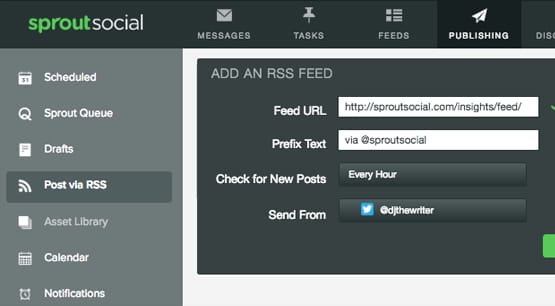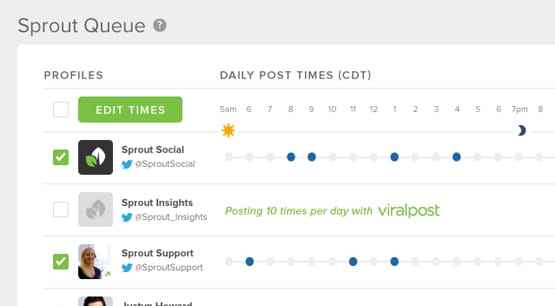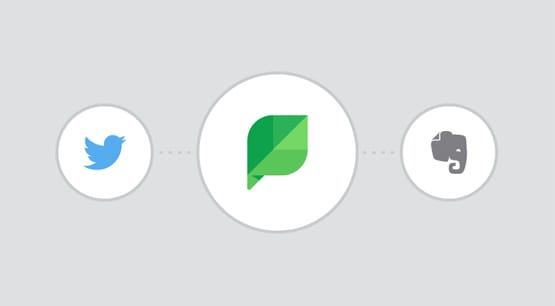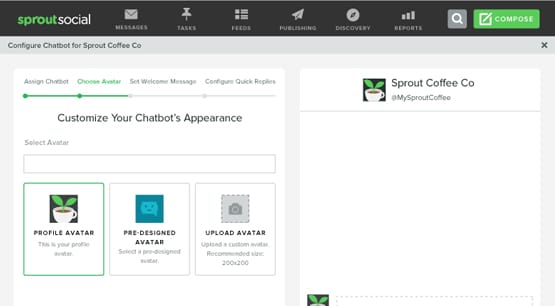Is it Safe to Use Sprout Social to Automate Your Profiles?

As I say so often on this site, automation is a tricky subject. The right kind of automation can save you hours every day, while tedious manual tasks chug away in the background without your input. The wrong kind of automation can flag your accounts as spam, post the wrong thing at the wrong time, or ruin customer interactions.
Automation is also of scaling value depending on the size of your business. A small business might benefit from automation because it’s cheaper than hiring a social media manager. A large company might be able to hire a department to do the work for them with minimal automation and a human touch that sets them apart. Or they, too, could save money using automation software and not lose much for it. Agencies that represent multiple businesses benefit most from automation of common tasks, though of course it’s important to keep each individual client segregated to avoid cross-posting in a way that shouldn’t happen.
Sprout Social Automation
Sprout Social is a huge platform with a lot of varied offerings for businesses both small and large. They have tools for engagement management, social monitoring, social listening, publishing, analytics, and more. I’m not here to give you a total review of all of their features, though; I’m just going to focus on their automation tools.
Automation comes through in five areas with Sprout Social, though only three are actually listed on their automation page. These are:
- Automatic social listening reports.
- Automatic customer engagement management.
- Automated post scheduling.
- Automated Twitter management.
- Chatbots.
Let’s cover each of these in detail.
Social Listening Automation
Social listening is the art of monitoring social networks for times when your brand and product are mentioned but you’re not explicitly tagged. It allows you to reach out and address problems with your products or brand appearance even when you’re not technically invited to do so. Someone whining about a problem they’re having? You can put a customer service agent on task to solve it. A product arrives broken? You can reach out and send a free replacement.
The automation here comes from the scanning and reporting that Sprout Social will do for you. They don’t actually do the reaching out for you. It’s low-key automation, for sure.
Social listening is a very important aspect of running a business that has a solid social presence. You want to be able to keep an eye out for three things.
- Occasions where someone is disappointed or angered by you or your product. These are opportunities to make things right and provide good customer service.
- Occasions where someone is delighted or impressed by you or your product. These are opportunities to leave a simple “hey, thanks!” message in response to show you appreciate customers.
- Occasions where people are talking about pain points in their business or their life. When the right pain points come up, you can recommend your product and even provide a free trial to get a customer through outreach.
Sprout Social’s social listening service lets you set up monitoring and get reports delivered to you when there’s an opportunity for you to take action. You don’t have to go out and check. Like I said, it’s low-key automation, but that’s what makes it perfectly safe to use.
Customer Engagement Automation
Sprout Social’s customer engagement automation is only technically automation because it does a lot of tedious work that, honestly, many businesses might not think to do themselves. It saves you time if you were doing it by hand, but if you weren’t doing it at all, it’s not a time saver. It is, however, a hugely useful feature.
What Sprout Social does here is gathers up information about your customers and builds individual customer profiles. When you link up Facebook, Twitter, Instagram, Google+, and whatever other social networks you have, you build one central “smart inbox” out of your message feeds. When people message you, the smart inbox will look for other cases where that user has messaged you, particularly on other sites. You’ll be able to see all of the interactions you’ve had with each individual regardless of platform.
This helps you avoid instances where a customer reaches out to you on Facebook, then later does so on Twitter and you have no record of previous interactions. It also helps avoid cases where a customer tries to abuse different contact methods to get repeated free samples.
Some other smart automation features help prioritize messages coming in from various platforms to put the most “needs attention” messages up top. You can manually tag and filter messages as well.
Again, this is such light “automation” that Sprout Social doesn’t even categorize it as automation. I barely do as well, but it’s just worth mentioning because of the value it can bring to your business doing something you otherwise would have to do by hand. My verdict: perfectly safe.
Post Scheduling Automation
First of the three forms of automation actually listed as automation on Sprout Social’s page, scheduling is one of the most basic forms of automation we all use and we all almost take for granted. Just imagine if you had to manually publish a post every time you wanted one to go up, and if you were a bit too slow or a bit too fast, the publication time reflected it. That kind of lack of control was common in the 90s, but since then, we’ve moved beyond such basic problems.
If basic scheduling was all Sprout Social did, I’d call it perfectly safe. Hell, you can schedule posts directly with Facebook and Twitter. There’s nothing wrong with it except the potential for human error. For example, if you accidentally choose 3am instead of 3pm for a post, it’ll happily post up in the small hours of the night, and you’re just going to have to deal with it if you don’t notice.
Automation of posts does have some pitfalls. One I commonly cite is an NRA post the day after a shooting in Colorado. The NRA account posted “Good morning, shooters. Happy Friday! Weekend plans?” mere hours after a mass shooting that killed 12 people. The timing is appalling, but we all know why it happened; a scheduled post was overlooked in the wake of tragedy.
Certain kinds of brands have to keep this kind of occurrence in mind. The NRA has to be constantly vigilant about the connotation of their messaging and the national climate with regards to the gun control debate. A lot of other brands don’t really have to worry about it. I guess Hershey would probably want to double-check if they had any scheduled tweets about factory tours if someone dies in an accident in their factory, but pretty much any company can fall victim to such a rare circumstance.
Anyway, Sprout Social actually takes post automation one step further. They allow you to put items in a queue and then let it do its thing. It analyzes your audience and their habits, their engagement levels, and the type of content you have available to post.
This kind of automation is considered generally safe, but can encounter an occasional hiccup. I’ve seen a few odd trends cause spikes in poorly-timed activity because they just happen to jog the algorithm in a weird way. That said, generally an algorithm is going to be at least as good at scheduling as you would be on your own, and can do it faster. You just need to double-check it occasionally to make sure it hasn’t gone off the rails. It can also be worthwhile to force some posts at odd times just to feed in more data and make the algorithm more accurate. Still, that’s up to you to experiment with.
Twitter Automation
Sprout Social’s second form of actual automation they list is Twitter automation software that is billed as enhancing the efficiency with which you reply to messages. It ties into the smart inbox feature and essentially gives you a set of templates for potential responses to customers who reach out.
Importantly, it doesn’t do it for you. When a customer sends you a message, you have a handful of buttons. If the customer is irate and demanding a refund, you hit the “sorry about your issue, can you send me your order number?” button. If the customer is asking when your store hours are, you hit the store hours button. If the customer is asking about your pricing, you hit the button to include a link to the pricing page on your website.
Sprout Social attempts to make this as relevant as possible by allowing you to set up a variety of different messages with different purposes, and then dynamically picking options for you based on the context of the message you receive. This can mean a much quicker response times, but it can also mean a few keywords can flag something incorrectly and mean your suggestions don’t work.
This is fine if you have an intelligent human at the helm, overseeing which messages you actually send, and that’s the way Sprout Social was designed. It doesn’t do automatic replies, just template-based replies. If you put a poorly-paid temp or an unpaid intern at the helm, or outsource to a digital call center in Bangladesh, you’re likely to end up with miscommunications or templates sent in response to inappropriate situations.
Chat Automation
The final part of Sprout Social’s automation is the chatbot builder. This is actually listed first on their automation page, but I put it last because I want to discuss it at a point where you’re most likely to take away the information.
Sprout Social has chatbot functionality for both Twitter DMs and Facebook Messenger, both of which are supported in limited fashion by the platforms themselves. This alone is fine. Bots do not reach out and send unsolicited messages to potential customers; they simply facilitate responses to incoming messages. Think of it like the above template-based responses, but with a bot there to interpret and send the templates.
The problem with such chatbots is the same as using an unpaid intern to hit the button. They operate based on keywords, and while they can be quite clever, they don’t learn or grow on their own. You have to build the workflow, so it’s only as smart as you are. You need a human to oversee the chats and intercede if they aren’t working properly.
This makes using the Sprout Social chatbot builder a somewhat risky venture. You aren’t likely to get your accounts banned or anything like that, but you may alienate or irritate some users who just want to talk to humans, not programs.
Also, if you really want to invest in a chatbot, there are better systems out there to create and use them. Sprout Social has the benefit of integrating it right into their smart inbox, but that’s about it. Other bot builders have more sophisticated options or a more robust creator. Of course, it’s always down to personal preference. If you want a chat bot, you can use any of a dozen different apps. If you want everything I’ve written about, you can use Sprout Social.
Is the Sprout Social bot builder safe? Well, it’s safe enough. Again, you’re pretty unlikely to get banned using it. You just need to be careful to make sure it’s providing more value than irritation.
Overall, I would say that Sprout Social is safe to use for your profiles, so long as you use it appropriately. With the personal information it puts at your fingertips it can be tempting to say things you shouldn’t as a business, and you have the constant risk of automating some interactions that would be better left personal. Either way, it’s all in how you use it; nothing about the platform itself is dangerous.









